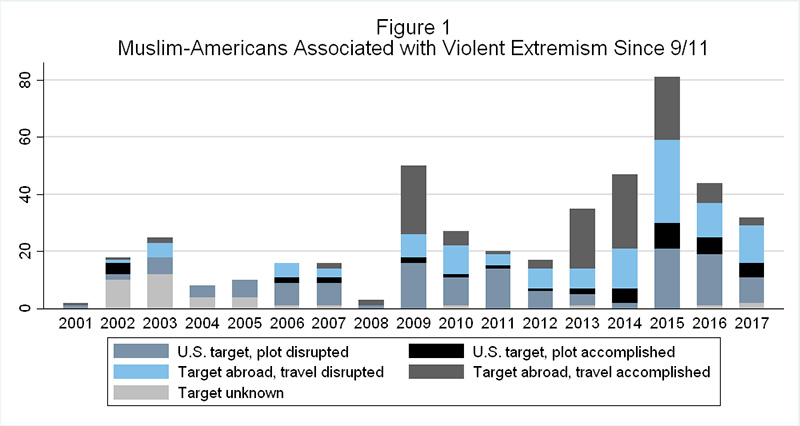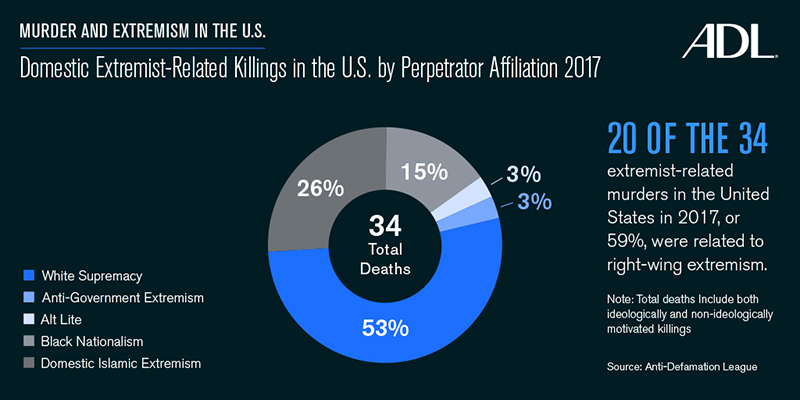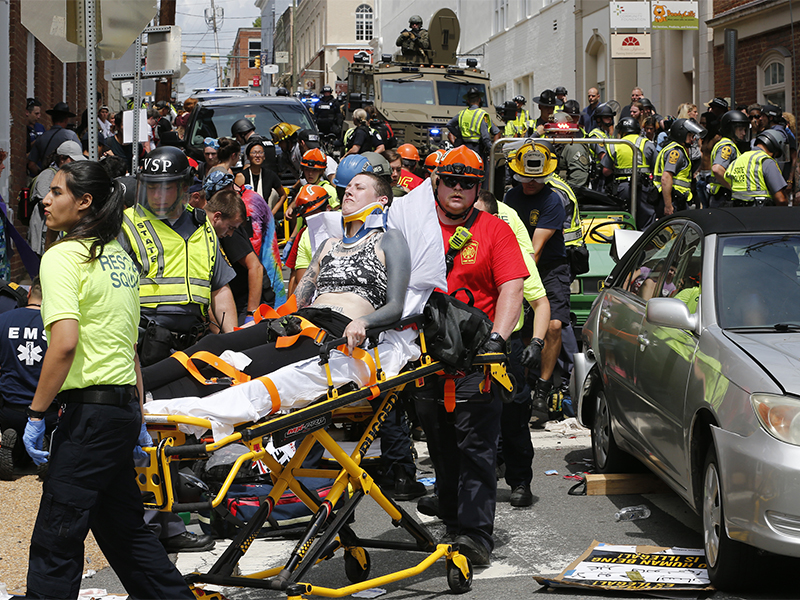(RNS) — To hear it from the Trump administration, Muslim extremists pose the greatest risk to Americans today.
Shortly after a judge blocked his ban on travelers from mostly Muslim countries, President Trump tweeted that “many very bad and dangerous people may be pouring into our country.”
The president’s National Security Strategy, issued last month, identifies “jihadi terrorists as the primary transnational threats Americans face.”
And just this week, the administration released a report attempting to link immigrants to terrorism, a report The New York Times, the Daily Beast, the Intercept and others called “misleading.”
[ad number=“1”]
But two new independent studies issued this week show that the number of Muslim Americans associated with violent extremism in 2017 continued to fall, and the number of Americans killed by white supremacists in the U.S. last year was far higher than those killed by Muslim extremists. More specifically, over the last decade 71 percent of all terrorism-related fatalities have been linked to domestic right-wing extremists, while 26 percent of the killings were committed by Islamic extremists.
The studies come as news that Zulfi Hoxha, an American from New Jersey, has become a senior commander of the so-called Islamic State group and one of the faces of the group’s recruitment efforts, according to federal court records. Hoxha, whose father is Albanian, left the U.S. in 2015 and was recently seen in a gruesome video beheading a person.
He would not have been featured in two new reports detailing Muslim extremism in the U.S. in 2017 because he was not in the country.
Both reports suggest the level of anxiety about Islamic extremism has far outpaced the actual scale of the threat.
[ad number=“2”]
One report, issued by the North Carolina-based Triangle Center on Terrorism and Homeland Security, finds that 33 Muslim Americans were associated with violent extremism in 2017, a 25 percent drop from 2016. Of those, just over half traveled or attempted to travel to join militant groups overseas. Fourteen were associated with plots against targets in the United States, and two cases involved unknown targets.

“Muslim-Americans Associated with Violent Extremism Since 9/11” Graphic courtesy of Charles Kurzman
“We have not seen hundreds, much less thousands, of Muslims in the United States responding to the call of militant organizations each year,” said Charles Kurzman, the report’s author, a professor of sociology at the University of North Carolina, Chapel Hill, and a specialist on Islamic movements.
The other study, by the Anti-Defamation League, found 34 extremist-related killings in the United States in 2017.
Muslim extremists have been accused in nine of those killings: According to authorities, eight people died after Sayfullo Saipov, an Uzbek native, rammed a rental truck down a New York City bike path in October; the ninth fatality, a Denver Regional Transportation District security officer, was shot dead by Joshua Andrew Cummings, a convert to Islam, in February.
The remaining 25 extremist killings in 2017 were at the hands of white supremacists, black nationalists and other radical groups. The victims included Heather Heyer, an anti-racism activist, killed when white supremacist James Alex Fields Jr. drove his car into a crowd of protesters in Charlottesville, Va.

“Domestic Extremist-Related Killings in the U.S. by Perpetrator Affiliation 2017” Graphic courtesy of the Anti-Defamation League
“There’s a great deal of concern about all kinds of extremism, but we need to be concerned about the reality that right-wing extremism is simply the larger share of the murder and the greatest source of the violence,” said Jonathan Greenblatt, CEO and national director for the ADL.
Greenblatt suggested a raft of policy changes, including federal and state programs to counter violent extremism in addition to adequate legal protections for victims of online harassment, cyberbullying and cyberstalking.
Deaths at the hands of violent extremists accounted for a small slice of the overall killings in 2107. Compared with the 34 fatalities from violent extremism, there were 272 fatalities from mass shootings in 2017.
[ad number=“3”]
Still, in many ways Muslim extremism gets a disproportionate amount of attention. Since the coordinated terrorist attacks of Sept. 11, 2001, 140 Americans have been killed by Muslim extremists in the U.S.
One of Trump’s earliest and most controversial actions in office was to block travelers from a handful of countries — most of them predominantly Muslim — from coming to the United States.
Courts had effectively halted three iterations of that executive order until the Supreme Court allowed the latest version to go into effect last month while legal challenges continue. In the current order, the mostly Muslim countries on the list include Chad, Syria, Iran, Libya, Somalia and Yemen.
“You have a tremendous perception gap,” said Ibrahim Hooper, national communications director for the Council on American-Islamic Relations. “It creates a situation where all violence is viewed from a prism of immigration or Islam.”
Hooper said narrowing that gap is a challenge, especially since many Americans don’t view non-Muslim violence as terrorism.
“All we can do is point to the facts,” he added. “But when you have an administration that isn’t truth- or data-driven, it makes it difficult.”





